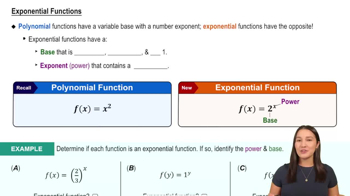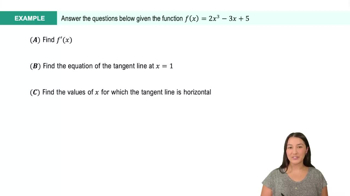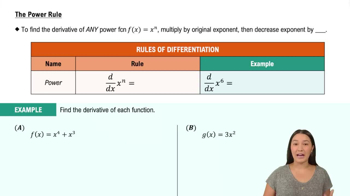Table of contents
- 0. Functions7h 52m
- Introduction to Functions16m
- Piecewise Functions10m
- Properties of Functions9m
- Common Functions1h 8m
- Transformations5m
- Combining Functions27m
- Exponent rules32m
- Exponential Functions28m
- Logarithmic Functions24m
- Properties of Logarithms34m
- Exponential & Logarithmic Equations35m
- Introduction to Trigonometric Functions38m
- Graphs of Trigonometric Functions44m
- Trigonometric Identities47m
- Inverse Trigonometric Functions48m
- 1. Limits and Continuity2h 2m
- 2. Intro to Derivatives1h 33m
- 3. Techniques of Differentiation3h 18m
- 4. Applications of Derivatives2h 38m
- 5. Graphical Applications of Derivatives6h 2m
- 6. Derivatives of Inverse, Exponential, & Logarithmic Functions2h 37m
- 7. Antiderivatives & Indefinite Integrals1h 26m
- 8. Definite Integrals4h 44m
- 9. Graphical Applications of Integrals2h 27m
- 10. Physics Applications of Integrals 2h 22m
3. Techniques of Differentiation
Basic Rules of Differentiation
Problem 3.26
Textbook Question
Derivatives Find the derivative of the following functions. See Example 2 of Section 3.2 for the derivative of √x.
f(v) = v¹⁰⁰+e^v+10
 Verified step by step guidance
Verified step by step guidance1
Step 1: Identify the function components. The function f(v) = v^{100} + e^v + 10 consists of three terms: v^{100}, e^v, and 10.
Step 2: Differentiate the first term v^{100}. Use the power rule, which states that the derivative of v^n is n*v^{n-1}. Therefore, the derivative of v^{100} is 100*v^{99}.
Step 3: Differentiate the second term e^v. The derivative of e^v with respect to v is simply e^v, as the exponential function is its own derivative.
Step 4: Differentiate the constant term 10. The derivative of a constant is 0, as constants do not change with respect to the variable.
Step 5: Combine the derivatives of each term. The derivative of the function f(v) is the sum of the derivatives of its individual terms: 100*v^{99} + e^v + 0.
 Verified video answer for a similar problem:
Verified video answer for a similar problem:This video solution was recommended by our tutors as helpful for the problem above
Video duration:
4mPlay a video:
Was this helpful?
Key Concepts
Here are the essential concepts you must grasp in order to answer the question correctly.
Derivatives
A derivative represents the rate at which a function changes at any given point. It is a fundamental concept in calculus that measures how a function's output value changes as its input value changes. The derivative can be interpreted as the slope of the tangent line to the curve of the function at a specific point.
Recommended video:

Derivatives
Power Rule
The Power Rule is a basic differentiation rule used to find the derivative of functions of the form f(x) = x^n, where n is a real number. According to this rule, the derivative is given by f'(x) = n*x^(n-1). This rule simplifies the process of differentiating polynomial functions, making it essential for solving problems involving powers of variables.
Recommended video:
Guided course

Power Rules
Exponential Functions
Exponential functions are functions of the form f(x) = e^x, where e is the base of the natural logarithm. The derivative of an exponential function is unique because it is equal to the function itself, meaning f'(x) = e^x. Understanding how to differentiate exponential functions is crucial for solving calculus problems involving growth and decay models.
Recommended video:

Exponential Functions

 3:59m
3:59mWatch next
Master Derivatives of Linear Functions with a bite sized video explanation from Callie
Start learningRelated Videos
Related Practice







